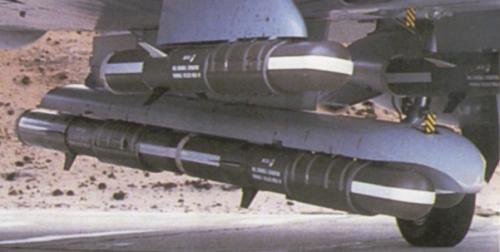MBDA (Matra) BLU-107/B Durandal
The Durandal rocket-boosted anti-runway munition was developed by Matra (now part of MBDA) in the 1970s, and entered service with the French Air Force in 1977. After release from the delivery aircraft, a parachute retarder system slows the Durandal until its nose has pitched down about 20° to 30°. Then the parachutes are released, and the solid-fueled rocket motor ignites to propel the Durandal to a speed of about 260 m/s. At that speed, the weapon's warhead can penetrate about 400 mm of concrete. A time-delay fuze detonates the warhead one second after impact, creating a crater of 5 m and a heavily damaged area of 7 m diameter.
 |
| Photo: via GlobalSecurity.org |
| BLU-107/B |
The U.S. Air Force first evaluated the Durandal in 1982. It was subsequently procured for operational service as the BLU-107/B, at least partly because the USAF's own BLU-106/B BKEP (Boosted Kinetic Energy Penetrator) program suffered from delays (and was later cancelled). The BLU-107/B was used in Iraq by F-111E bombers during Operation Desert Storm in early 1991. After retirement of the F-111, the F-16 became the only USAF platform for the Durandal.
Specifications
Note: Data given by several sources show slight variations. Figures given below may therefore be inaccurate!
Data for BLU-107/B:
| Length | 2.50 m (8.2 ft) |
| Diameter | Warhead & motor: 21.2 cm (8.35 in) Parachute section: 22.3 cm (8.78 in) |
| Wingspan | 43 cm (16.93 in) |
| Weight | 219 kg (483 lb) |
| Speed | 260 m/s (853 fps) |
| Propulsion | Solid-fueled rocket; 92.4 kN (20770 lb) |
| Warhead | 100 kg (220 lb) penetrator |
Main Sources
[1] Christopher Chant: "World Encyclopaedia of Modern Air Weapons", Patrick Stephens Ltd., 1988
[2] GlobalSecurity.org Website
Back to Directory of U.S. Military Rockets and Missiles, Appendix 4
Last Updated: 7 June 2006